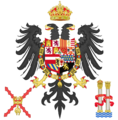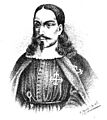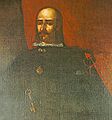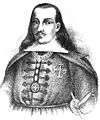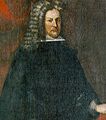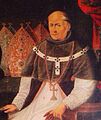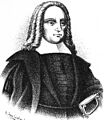List of viceroys of Peru facts for kids
Quick facts for kids Viceroy of Peru |
|
|---|---|
| Residence | The Viceroy Palace (Now the Government Palace) |
| Appointer | The King of Spain |
| Formation | 26 July 1529 |
| First holder | Francisco Pizarro |
| Final holder | Pío de Tristán |
| Abolished | 30 December 1824 |
This article tells you about the important leaders called viceroys of Peru. A viceroy was like a special governor who ruled a huge area in the name of the King of Spain. They were in charge of the Viceroyalty of Peru from 1544 to 1824.
In the 1500s and 1600s, the viceroys controlled almost all of South America. The only part they didn't rule was eastern Brazil. These leaders played a big role in the history of Peru and the entire continent.
Contents
Early Spanish Leaders in Peru (1532–1544)
Before the official viceroys, there were other important Spanish leaders in Peru. These leaders were called governors. They helped Spain take control of the land.
Who Was Francisco Pizarro?
The first major Spanish leader was Francisco Pizarro. He arrived in Peru in 1532. Pizarro led the Spanish conquest of the Inca Empire. He became the governor of a new Spanish territory called New Castile. He ruled from July 26, 1529, until June 26, 1541.
Other Early Governors
After Pizarro, Cristóbal Vaca de Castro took over. He was governor from August 7, 1542, to May 17, 1544. There was also Gonzalo Pizarro, Francisco's brother. He tried to claim power, but his rule was not officially recognized by Spain. His claims led to conflicts.
Viceroys of Peru: Spanish Rule (1544–1824)
The official period of the viceroys began in 1544. These leaders were directly appointed by the King of Spain. They had a lot of power. Their job was to make sure Spain's laws were followed and to manage the vast lands.
First Viceroys and Their Challenges
The very first viceroy was Blasco Núñez Vela. He started his rule on May 15, 1544. However, his time as viceroy was short. He faced many challenges and conflicts. He died in January 1546.
After him, Pedro de la Gasca took over temporarily. He helped bring order back to the region. Then came Antonio de Mendoza in 1551. He was an experienced ruler. He had already been a viceroy in New Spain (Mexico).
Important Viceroys and Their Impact
Many viceroys ruled Peru over the centuries. Each one left their mark on the region. One of the most famous was Francisco de Toledo. He was the fifth viceroy and ruled from 1569 to 1581. He made many important changes. He organized the government and the economy. He also set up new laws for the native people.
Another notable viceroy was Melchor Portocarrero, 3rd Count of Monclova. He served for a long time, from 1689 to 1705. During his rule, he worked to improve the defenses of the colony. He also tried to stop smuggling.
The Last Viceroys and Independence
As the 1800s began, the Spanish Empire started to weaken. Many parts of South America began fighting for independence. The viceroys in Peru faced increasing challenges.
The last official viceroy was José de la Serna e Hinojosa. He took office in 1821. He fought against the independence movements. However, the Spanish forces were defeated at the Battle of Ayacucho in December 1824. This battle marked the end of Spanish rule in Peru.
After this defeat, Pío de Tristán briefly held the title of viceroy. But his time was very short. The Viceroyalty of Peru officially ended on December 30, 1824. This marked the beginning of Peru as an independent nation.
Images for kids
-
Charles I, King of Spain during the early viceroyalty.
-
Philip III, King of Spain.
-
Philip IV, King of Spain.
-
Charles II, King of Spain.
-
Philip V, King of Spain.
-
Louis I, King of Spain.
-
Ferdinand VI, King of Spain.
-
Charles III, King of Spain.
-
Charles IV, King of Spain.
-
Ferdinand VII, King of Spain.
See also












